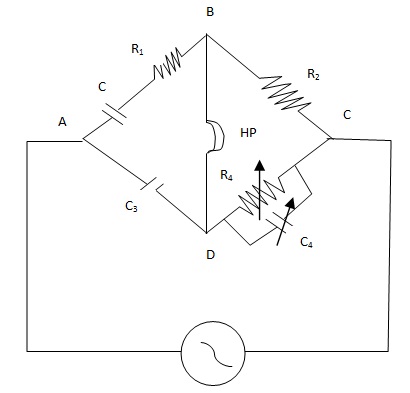Schering Bridge
Schering Bridge Assignment Help | Schering Bridge Homework Help
Schering Bridge
It is used for the accurate measurement of small capacitance. The unknown capacitor C is connected in arm AB along with the associated resistance R1 in series. The arm AD contains a standard capacitor C3 having negligible resistance. The two remaining arms BC and CD contain non-conductive R2 and R4. A variable calibrated air capacitor C4 is put in parallel with R4. The bridge is balanced by varying R4 and C4.Theory. The general balance condition of an a.c. bridge is
Z1/Z2 = Z1/Z4
Z1 = R1 + 1/jωC, Z2 = R2, Z3 = 1/jωC3 and 1/Z4 = 1/R4 + 1/1/ jωC4
R1 + 1/ jωC/R2 = 1jωC3(1/R4 + jωC4)
Or R1 + 1/ jωC = R2/ jωC3 R4 + R2C4/C3
Equating the real and imaginary parts, we get
R1 = R2 C4/C3 … (1)
And 1/C = R2/C3R4
Or C = R4/R2C3 … (2)
C can be calculated using Eq. (2)
Advantages. This bridge is used for the measurement of dielectric constants, particularly of liquids. It provides the accurate determination of very small capacitances. In industries it is widely used in testing of cables and insulators at high voltages.
